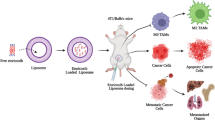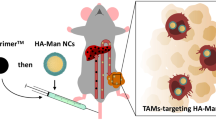We studied the effect of zoledronic acid encapsulated into liposomes (L-ZOL) on tumorassociated macrophages in the stroma of hepatocellular carcinoma xenograft. Liposomes were prepared from 1,2-dipalmitoyl-sn-glycero-3-phosphocholine, 1,2-dipalmitoyl-snglycero-3-phospho-sn-1-glycerol, and 1,2-distearoyl-sn-glycero-3-phosphoethanolamine-N-[carboxy(polyethylene glycol)-2000] using thin film method and loaded with zoledronic acid. It was shown that L-ZOL promoted apoptosis of RAW264.7 cells, eliminate much more protumoral M2 macrophages than antitumoral M1 macrophages in the tumor xenograft, and did not significantly reduce the size of xenograft in 6 days. Thus, the effect of treatment depends on the ratio between antitumoral M1 and protumoral M2 polarized macrophages in the tumor.
Similar content being viewed by others
References
Binnemars-Postma K, Bansal R, Storm G, Prakash J. Targeting the Stat6 pathway in tumor-associated macrophages reduces tumor growth and metastatic niche formation in breast cancer. FASEB J. 2018;32(2):969-978. doi: https://doi.org/10.1096/fj.201700629R
Brown JM, Recht L, Strober S. The Promise of Targeting Macrophages in Cancer Therapy. Clin. Cancer Res. 2017;23(13):3241-3250. doi: https://doi.org/10.1158/1078-0432.CCR-16-3122
Cassetta L, Pollard JW. Targeting macrophages: therapeutic approaches in cancer. Nat. Rev. Drug Discov. 2018;17(12):887-904. doi: https://doi.org/10.1038/nrd.2018.169
den Breems NY, Eftimie R. The re-polarisation of M2 and M1 macrophages and its role on cancer outcomes. J. Theor. Biol. 2016;390:23-39. doi: https://doi.org/10.1016/j.jtbi.2015.10.034
Gordon S, Martinez FO. Alternative activation of macrophages: mechanism and functions. Immunity. 2010;32(5):593-604. doi: https://doi.org/10.1016/j.immuni.2010.05.007
Mills CD, Kincaid K, Alt JM, Heilman MJ, Hill AM. Pillars Article: M-1/M-2 Macrophages and the Th1/Th2 Paradigm. J. Immunol. 2000. 164: 6166-6173. J. Immunol. 2017;199(7):2194-2201. doi: https://doi.org/10.4049/jimmunol.1701141
Ringleb J, Strack E, Angioni C, Geisslinger G, Steinhilber D, Weigert A, Brüne B. Apoptotic Cancer Cells Suppress 5-Lipoxygenase in Tumor-Associated Macrophages. J. Immunol. 2018;200(2):857-868. doi: https://doi.org/10.4049/jimmunol.1700609
Salzano G, Marra M, Porru M, Zappavigna S, Abbruzzese A, La Rotonda M.I, Leonetti C, Caraglia M, De Rosa G. Self-assembly nanoparticles for the delivery of bisphosphonates into tumors. Int. J. Pharm. 2011;403(1-2):292-297. doi: https://doi.org/10.1016/j.ijpharm.2010.10.046
Sawa-Wejksza K, Kandefer-Szerszeń M. Tumor-Associated Macrophages as Target for Antitumor Therapy. Arch. Immunol. Ther. Exp. (Warsz). 2018;66(2):97-111. doi: https://doi.org/10.1007/s00005-017-0480-8
Tacke F. Targeting hepatic macrophages to treat liver diseases. J. Hepatol. 2017;66(6):1300-1312. doi: https://doi.org/10.1016/j.jhep.2017.02.026
Torre LA, Bray F, Siegel RL, Ferlay J, Lortet-Tieulent J, Jemal A. Global cancer statistics, 2012. CA Cancer J. Clin. 2015;65(2):87-108. doi: https://doi.org/10.3322/caac.21262
van Rooijen N, Hendrikx E. Liposomes for specific depletion of macrophages from organs and tissues. Methods Mol. Biol. 2010;605:189-203. doi: https://doi.org/10.1007/978-1-60327-360-2_13
Author information
Authors and Affiliations
Corresponding author
Additional information
Translated from Byulleten’ Eksperimental’noi Biologii i Meditsiny, Vol. 170, No. 7, pp. 84-90, July, 2020
Rights and permissions
About this article
Cite this article
Wu, S., Lin, X. & Cui, X. Effect of Liposome-Encapsulated Zoledronic Acid on Microenvironment of Hepatocellular Carcinoma May Depend on the Ratio Between M1 and M2 Polarized Macrophages. Bull Exp Biol Med 170, 69–74 (2020). https://doi.org/10.1007/s10517-020-05006-1
Received:
Published:
Issue Date:
DOI: https://doi.org/10.1007/s10517-020-05006-1




